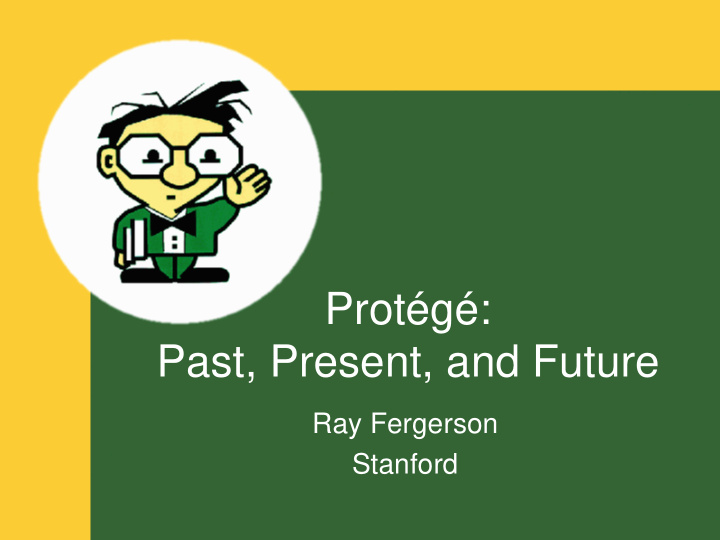



Protégé: Past, Present, and Future Ray Fergerson Stanford
Past • Ancient History (1985-1997) – Mark Musen’s Thesis – Protégé-II, Protégé/Win – “Workshops” 1-2 • Modern Era (1997-2003) – Protégé in Java – Workshops 3-6
Mark’s Thesis • PROTÉGÉ system • Developed as a tool for building knowledge-acquisition tools (a meta-tool ) for medical planning applications • Hardcoded Ontology (or meta-ontology) geared for planning applications • Written in Lisp, Ran on Lisp machines • User community: ~1
Protégé -II • Generic meta-tool – No hardcoded ontology – No assumptions about “planning” • Constructed as three distinct applications: – ontology editing – form customization – instance creation • Written in Objective-C, Lisp…, Ran in NextStep • User community ~10
“Workshop” 1 – June 1995 Pavia, IT • Four guys from four different countries meeting in a pizza restaurant • Conclusions: – The pizza in Italy is really good – Too much Chianti makes discussing ontologies difficult
Protégé /Win • DARPA funding – required MS Windows reimplementation • Protégé/Win – Same three applications as Protégé-II – Written in C++, ran on Windows 95+ • User community ~100
“Workshop” 2 – March 1996 Stanford, US • Decided to re-implement Protégé/Win as a framework into which user-created plug-ins could be added. – domain-specific slot widgets – read/write data to other file formats • Decided to adopt Java programming language
Workshop 3 – Sept. 1997 Lidingö, SE – Henrik Eriksson • Prototype of new system: Protégé/Java • Described ability to add tabs • Subsequently decided… – We haven’t gone “far enough” to integrate with other knowledge-base systems such as Ontolingua, CYC, and Loom – To adopt Generic Frame Protocol (OKBC) as our knowledge model – Throw away previous work and start over
Workshop 4 – July 1999 Linköping, SE – Henrik Eriksson • Protégé-2000 Release 1.0 • Users demonstrated: – new domain independent slot widgets – tab widgets
Workshop 5 – July 2001 Newcastle, UK – Neil Jones • Protégé-2000 1.6 (almost) released • Free • Open source • Growing and diverse user community – 1000 registered users
Workshop 6 – July 2003 Manchester, UK – Alan Rector • Protégé-2000 1.9 (almost) released – Protégé 2.0 promised for “fall 2003” • delivered in February, 2004 • Multiuser client & server • Reimplemented Diagram/GraphWidget • OWL Plugin Beta • Almost 10000 registered users
Present • Staff • Mailing Lists • User community • Funding • Release schedule – Since last workshop – Going forward
Protégé Team • Research – Monica Crubézy – Olivier Dameron semantic web tech, modeling principles – Holger Knublauch – Natasha Noy – Daniel Rubin biomedicine, imaging, NLP – Samson Tu • Administration – Ted Hopper making sure things run smoothly • Development – Ray Fergerson – Jennifer Vendetti
Mailing Lists • protege-discussion – 2300 members – 9700 messages • Created protege-owl mailing list • Messages viewable as newsgroups, html http://gmane.org
Registrations / Week 100 150 200 250 300 350 400 450 500 50 0 Jan '01 Apr '01 Jul '01 User Community Oct '01 Total Registered Users: ~20000 Protege Weekly Registration Totals Jan '02 Apr '02 Jul '02 Oct '02 Jan '03 Apr '03 Jul '03 Oct '03 Jan '04 Apr '04
2004 Conference Attendees Academic 75 Commercial 72 Government 45 Non-Profit 17
Conference Attendance 250 200 150 People 100 50 0 1994 1995 1996 1997 1998 1999 2000 2001 2002 2003 2004 2005 Year
Extrapolated Conference Attendance 10,000,000,000 1,000,000,000 100,000,000 10,000,000 1,000,000 Protege Conference Attendence Prague Strahov Stadium Capacity 100,000 People Earth's Population Extrapolated Conference Attendence 10,000 1,000 100 10 1 1995 2005 2015 2025 2035 2045 Year
Funding • National Library of Medicine – Resource Grant: “National Resource for Biomedical Ontologies and Knowledge Bases” • National Cancer Institute Center for Bioinformatics – Development Contract • Protege Affiliates: – Daimler-Chrysler
Since Last Workshop • Release 2.0 & 2.1 • Multiuser client & server • Support for ~5M frames • Web Browser Interface • OWL Support • Improved support for plugins – Bundling – Isolation – Built-in About Box and Documentation support
Future • Continuing evolution of standard frame- based and OWL Plugin systems • User-Interface Improvements • Infrastructure Improvements • Schedule “Improvements”
Core and OWL Plugin Systems • OWL Plugin DL support layered on top of the core OKBC frame support – Allows conversion between two systems – Poses a number of development challenges – Provides advantages of giving users: • Choice of simpler frame-based or DL interface for editing OWL • Access to a variety of plugins • Plan continued parallel system development and evolution
Retirement Announcement
User Interface Improvements • Application Changes – Cleaner – More Attractive – More Professional – Easier to Learn – Easier to Navigate • Web Site Changes “ditto”
Infrastructure Improvements • More Flexible Inclusion – Extensions of included frames – Database inclusion • Namespaces – already in OWL Plugin • Internationalization Support – Localization – Alternate names & values
Schedule “Improvements” • Now aim for two releases/year – Before conference (June) – ~6 months later • Betas releases roughly weekly • Compromise between: – “constant updates” – “too long before bugs get fixed”
Conference 7 Wish List • ??? (Come back on Friday at 11:00 am)
Recommend
More recommend